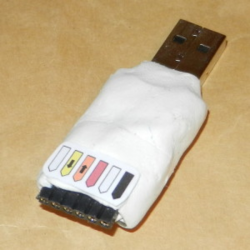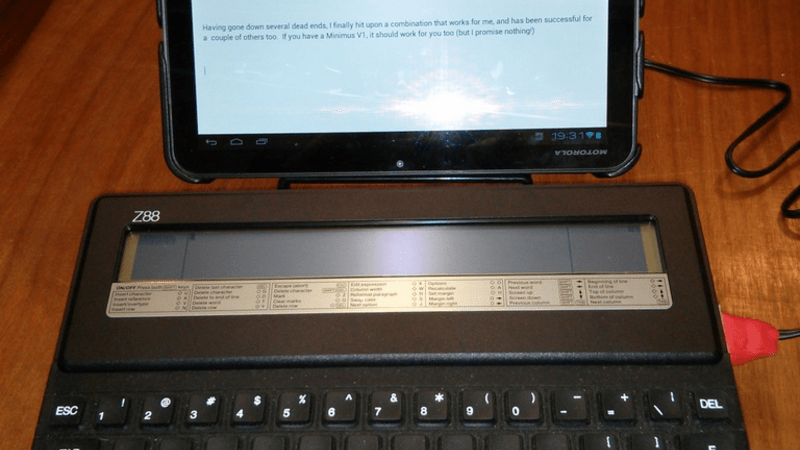What did [Clive Sinclair] do next? After his line of home computers including the iconic ZX Spectrum hit the buffers and was sold to Amstrad, that is. No longer in the home computer business, he released a portable computer for the business market. The Cambridge Z88 had a Z80 at its heart, a decent keyboard, a text-only LCD display, and ran for an impressively long time on a set of AA alkaline cells. It made a handy portable word-processor, or a serial terminal thanks to its rare-for-the-time RS232 port. And it’s that port that [Spencer Owen] made use of his Z88 in a modern setting, using it as a USB keyboard.
 It’s a few years old, so he used a Minimus AVR microcontroller board to provide a serial-to-USB HID keyboard interface, and to keep things tidy he’s made a poor man’s enclosure for it using Sugru. It’s not quite an amazing hardware hack, but we’re featuring it simply for its use of a Z88. Retro computers used as keyboards are a common theme, but a Z88 is a particularly eclectic choice.
It’s a few years old, so he used a Minimus AVR microcontroller board to provide a serial-to-USB HID keyboard interface, and to keep things tidy he’s made a poor man’s enclosure for it using Sugru. It’s not quite an amazing hardware hack, but we’re featuring it simply for its use of a Z88. Retro computers used as keyboards are a common theme, but a Z88 is a particularly eclectic choice.
If you’re not British you may only know the name [Sinclair] through Brits on the Internet waxing lyrical about their ZX Spectrum computers, but in fact the man behind them is a serial electronics entrepreneur whose career has continued since the 1960s and has touched fields as diverse as portable television and bicycles aside from the computers he is best known for. Often his products took technology to the limit of practicality, but they were and continue to be the ones to watch. If [Clive Sinclair] is working in a field his products may not always hit the right note when released, but you can guarantee that you’ll be buying the same thing from the big boys within a few years. The Z88 is a classic Sinclair product, a little before its time in 1988 and pushing the technology a little too far, but delivering a truly portable and capable computer with a meaningful battery life a couple of decades before you’d find the same attributes from all but a few other niche manufacturers.
Not had enough USB HID devices? How about a Morse key? And if [Spencer] rings a bell, he’s the originator of the RC2014 retrocomputer we reviewed last year.
















Thanks for reminding me about the one in my basement :)
I hope you took the batteries out when you stored it there.
It seemed to try and copy the format of the Tandy 100/102 that came out in 1983 and was already very successful with journalists. The Z88 being later the the party had the advantage of being smaller and lighter, but the squishy keyboard and hard to read screen didn’t do the Z88 any favours. Still it was reasonably popular in the UK for a computer coming from someone who had just gone bankrupt.
It did much more than the Tandy. Which was twice the size. Also he was never bankrupt but sold his failing business to Amstrad, there’s a difference.
Wrote my 1993 graduate thesis on motion picture image restoration in LaTex on a Z88, which I uploaded via serial to the university mainframe. The Z88 had a bigger display than the Tandy Model 100/102, and Pipedream (the word processor / spreadsheet-in-one package it shipped with) was pretty good. The little ‘page map’ on the right which showed an A4 page in pixel-per-character form so you could see where you were editing on the page, actually worked pretty well. Good battery life, an OK keyboard, and a good bundled word pro meant it worked well for me.
The Z88 had a screen that would display 80 characters wide instead of the 40 on the Tandy, but the screen was a lot smaller so somewhat more difficult to read.
Sinclair was also known for buying rejected transistors in bulk then having them individually tested and binned by their characteristics. That enabled lower prices on electronics kits, but I bet it’s a real PITA to repair one unless you have the schematic and parts list with the characteristics instead of just part numbers.
I am just happy that someone who puts a RS232 port on a computer is described as a serial entrepreneur :D
1++
…and kick started the Z88 dev kit – C compiler for a lot of Z80 based systems.
http://www.z88dk.org
I once heard that the person who pays the most income tax for any year in the U.K. is[can be?] Knighted.
Is that how Sir Clive received his O.B.E.?
Geffen?
Fairly sure it was services to British comedy, the C5 jokes kept stand up comedians going for a couple of years.
B^)
No. And no. The Spectrum basically laid the foundation for today’s IT industry in the UK.
I used to lust after one of these, and then later an Amstrad NC100… it took me a while though to realise that the NC100 was independently developed and was not a revision of the Z88.
“If you are not British…” Very familiar with Sinclair in the US. His computers were sold here through a partnership with Timex. My first computer was a Timex Sinclair 1000. I bought it and started writing a version of Snake using Sinclair basic to peek and poke video memory directly (tried with regular basic commands first but it was too slow). The TS 1000 only had 2k of memory so I didn’t get very far before I had to go out and buy the 16k memory expansion module. I was nearly finished but the program was behaving very oddly. I finally realized that the TS1000’s video memory didn’t occupy a fixed location in memory as I had assumed; any change to the program’s code changed video memory’s starting address. Once I accounted for that, I successfullly completed my first program and my future career choice as a software engineer was sealed. I later transferred the guts of my TS1000 to a new case with physical keyboard and added a “Stringy Floppy” for high speed storage before replacing it all with a C64. I still have the TS1000 case in all it’s membrane keyboard glory to remind me of my beginnings.
Ahh Z88, add a original mac serial cable, add a usb 2 mac serial adapter, and login like it’s 1988
Not sure how to embed an image here, but … https://i.imgur.com/XK6Miod.jpg
I’ve also got an NC100 thats fairly dead … I ought to do something about that…